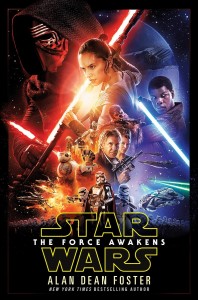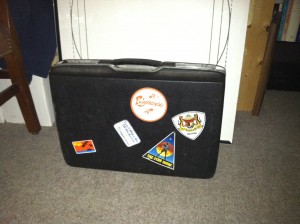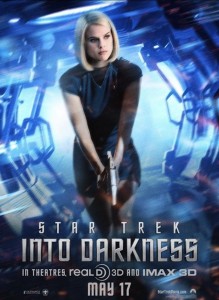In discussing some of the authors who influenced me early on, I missed a big name: Alan Dean Foster. If you’re a fan of any sort of SF media and you’ve ever picked up a book based on a movie, you’ve probably read him. You couldn’t miss. Foster’s earliest high-profile project was the
Star Trek Logs, a series of books which were based on the
Star Trek animated series of 1974 – 1975. He adapted the 22-minute scripts into novellas of about 70 pages each, fleshing them out and producing very entertaining reading. The novels outlasted the Saturday morning series by quite a measure of years, and are, I believe, still in print. I’m pretty sure this was the first and certainly one of the only times that an American children’s cartoon was novelized. Of course, a lot of the reason it was possible was that the scripts were not typical “children’s” fare. They were just half-length Star Trek episodes, overseen by many of the same creative lights responsible for the original TV series.And note that I put “children’s” in quotes in that last passage. I think the idea that children’s entertainment should be less sophisticated and of lower quality than its adult counterpart is dead. You can’t be sure, though. So I’ll make it clear that good childrens’ literature is much harder to create than adult lit that will pass as good. To make it as an adult writer, you only have to impress that segment of the population whose imaginations have already withered and died. Not as neat a trick as impressing a mind that’s wide-open and firing on all cylinders.Foster went on to ghost-write the novelization of
Star Wars and to author its original sequel,
Splinter of the Mind’s Eye. This was a book conceived at the time when
Star Wars was just the title of one movie, an entry in a much bigger project called The Adventures of Luke Skywalker. To this day, I wish someone had made that series instead of the one we got. And then Foster became king of the novelization. You name it, he probably wrote it: the
Alien novels, Carpenter’s
The Thing, Dark Star and even the most recent
Star Trek novelization. (A joy to listen to, by the way, if you want to pick up the audio book. It’s read by Zachary Quinto.)
Foster does well with other people’s stories because he’s got a gift of narrative. He knows how to tell a story in such a way as to pull you into it and make you feel you’re experiencing it. He throws in a lot of detail to give it depth – sounds, smells, textures – really creating a world in which his story, or anyone’s, can unfold. He’s rarely laugh-out-loud funny, and I rarely catch a political bent in his writing. Perhaps that’s part of the reason he excels at telling so many different kinds of stories. In fact, I managed to enjoy his novelization of Alien 3, despite the fact that I hated the story, and later learned Foster did too!
But Foster has a whole career beyond novelizations. Good thing too, as, in the days of Blu-Ray, I doubt there’s much market for them. He’s authored dozens of novels set in the World of the Commonwealth, a civilization built on the successful partnering of humans and the insectoid Thranx. He’s also written quite a number of fantasy novels, but, well, I don’t do fantasy. In fact, it was Foster who made me realize that. When his novel Spellsinger came out while I was in high school, I ran and bought it immediately. This was one of my favorite authors, after all. Never finished it. Don’t even think I made my usual trial run of 100 pages. It was then that I realized that even authors I like have a hard time making fantasy palatable to me. So I gave up. I’d already tried and failed at Tolkein, and later tried and failed with Piers Anthony and Ann McAffrey. It just ain’t happenin’.
But the Commonwealth, and particularly its most-chronicled residents, Flinx and Pip, are longtime favorites of mine. Foster created Flinx and his universe in his first published novel, The Tar Aiym Krang, in 1972. Flinx’s adventures aren’t groundbreaking. In fact, Flinx is very much the spiritual descendant of Heinlein’s Thorby in Citizen of the Galaxy. He’s a slave boy, bought by an elderly trader on a primitive world, who happens to have a pretty important past, and spends most of his adventures trying to figure out just who the hell he is and why he was made this way. And if Flinx owes a lot to Thorby, his Commonwealth, found by two races shortly after they discovered each other, owes a lot toStar Trek. The humans and the Thranx interact a lot like the humans and the Vulcans of Trek do, and the grasshopper-like Thranx all have the same scholarly dignity that Spock, Sarek and Surak carried around in their robes like chewing gum.
But the derivative aspect of these works is not a bad thing. If you’re going to build a reliable car, you look at how others have built their cars. If you want to make comfortable furniture, you use time-honored traditions. If you’re going to write entertaining space opera, you could try to do something totally new, but you’re probably better off relying on some proven staples of the genre so that your readers feel like they’re on familiar ground and can enjoy the ride. So you use the United Planets, or the Federation or the Commonwealth; you use Starfleet or the Lensmen or the Legion of Space; you introduce character archetypes like the lost prince or princess, the wise old alien scholar, or the old thief with the heart of gold. Readers shouldn’t get snitty about it, either. It’s how the process works. And odds are, if someone accuses you of stealing from a source, they’ll be surprised to learn that that source stole from somewhere else. (If there’s an original idea in Star Trek, it’s pretty well-hidden! But that doesn’t mean the show wasn’t a great piece of television or an entertaining piece of SF.)
And Flinx does have his unique aspects. We meet him when he’s seventeen, a red-headed boy of Indian descent who has psychic gifts (he used them to fleece tourists) and a very, very deadly flying snake, Pip, as a pet. As he comes of age, he learns that he’s pretty special. He’s the only one who can communicate with the Krang, a relic of an ancient civilization called the Tar Aiym. It’s also a very powerful weapon. The kid is comfortable with dangerous things.
In Orphan Star, the second entry in the series*, which I just read, Flinx has actively begun the search for his past. Picked up by an interplanetary organized crime boss who wants to use Flinx’s abilities to activate a hallucinogenic gem, Flinx is taunted by the man – seems Challis, the crime boss, knows something about Flinx’s mother. And so Flinx embarks on an adventure which puts him in the company of dangerous criminals, and carries him to the home of the insect-like Thranx, as well as to old home Terra and to the mysterious world of Ulru-Ujurr. Here he finds both a member of his family and a race of powerful beings who equip him with a spaceship of his own and the freedom to continue his quest.
Orphan Star is something of a coming-of-age story, but then the whole first trilogy of Flinx’s adventure is. He’s learning that the universe is a lot bigger than he conceived, that he has a very special place in it, and that his past is both mysterious and dangerous to pursue. More than a story of a boy becoming a man, though, it’s an absorbing adventure, full of well-drawn characters who often aren’t honest or moral, but are always interesting. Flinx emerges as a confident and competent hero, but never so super-human that a reader can’t empathize with him.
Again, I focus on Orphan Star as it’s the one I just read – or listened to, rather. It’s available in a very good reading from Brilliance Audio. I recommend the entire series, however.
* Every source published throughout the seventies and eighties insisted that Bloodhype was the second Flinx adventure. ‘Taint so. Flinx appears in it, yes; but not as a central character. The story is also set after he’s become an adult. Chronologically, it falls somewhere in the later series of Flinx books that Foster released after 2000. Tar Aiym Krang, Orphan Star and The End of the Matter form a pretty distinct trilogy. A later novel, For Love of Mother-Not, is the first chronological adventure, feature Flinx at age 14. But I’m a purist, and I’d recommend starting with the first-written novel.
 I explained last week why I’m so excited that Alan Dean Foster is back to novelize a new Star Wars film. The Force Awakens comes at a time when film novelizations aren’t as much of a thing as they used to be. In the 1950s, 60s and 70s, we weren’t a culture that went to see a movie multiple times, and there was no such thing as Blu-Ray, or its older brethren DVD, VHS or Beta. From the time a film went out of the theater, until it was bought for lots of money (and shown heavily edited) by a TV network, there was no way to enjoy the story and characters from your favorite film, other than by buying the novelization. Back in the day, even comedy films got novelizations. Now, it’s pretty much confined to SF films, and that’s pretty much because fans of those films tend to be both collectors and readers.
I explained last week why I’m so excited that Alan Dean Foster is back to novelize a new Star Wars film. The Force Awakens comes at a time when film novelizations aren’t as much of a thing as they used to be. In the 1950s, 60s and 70s, we weren’t a culture that went to see a movie multiple times, and there was no such thing as Blu-Ray, or its older brethren DVD, VHS or Beta. From the time a film went out of the theater, until it was bought for lots of money (and shown heavily edited) by a TV network, there was no way to enjoy the story and characters from your favorite film, other than by buying the novelization. Back in the day, even comedy films got novelizations. Now, it’s pretty much confined to SF films, and that’s pretty much because fans of those films tend to be both collectors and readers.




